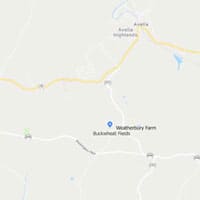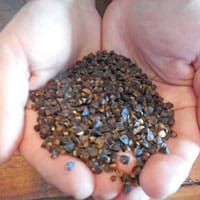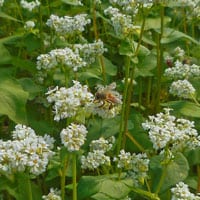Grain Tracker
Westsylvanian Common Buckwheat Facts 2016
In 2016, Westsylvanian Common Buckwheat was grown in Independence Township on 7 acres on our home farm. The farm is part of a 436 acre grant (known as Extravagance) surveyed to John Doddridge on April 6,1786. According to the Caldwell Atlas , the farm was established by M.T. Murdock in 1825. Murdock is listed as a farmer, grain, stock and wool grower (with 150 sheep). The farm was later a dairy operation (the Patterson family: 1945-1966) and a cattle operation (the Eastham family: 1966-1986). In 2008, we began raising historical grains on both the home farm and neighboring farms. The grains were certified organic in 2009. In April 2014 Weatherbury Farm began stone-grinding flour. Weatherbury Farm also raised grass fed beef.
The buckwheat was planted on August 4, 2016.
Clover was inter-seeded on the buckwheat fields on August 4, 2016. The clover suppresses weeds, aids in holding up the buckwheat and eventually provides nitrogen to the next crop. In our crop rotation, Wapsie Valley Corn follows buckwheat.
The buckwheat was swathed on October 19, 2016. At Weatherbury Farm, when the buckwheat is ~ 3/4rds mature, we utilize a swather to cut the buckwheat into windrows to stop deer and bird pressure on the crop. The windrow is laid on stubble for good air circulation. In the windrow, some dry matter will translocate into the nearly mature seeds and they will ripen. Windrowing increases the yield and also helps reduce shattering because it is done when the maturity is right, with the seed caught among the stems.
The buckwheat was harvested on November 1, 2016, allowing the buckwheat to cure for several days.
In 2016, we planted double the amount of buckwheat we normally do as a West Virginia distillery was planning to make buckwheat whiskey. Unfortunately, they ran into financial trouble and plans changed. The good news is that buckwheat stores very well in the hull and is safe from pesky pests. So when, we lost our 2018 crop due to wet weather, we still had buckwheat to mill!
For an illustrated explanation of how Weatherbury grains become flour, visit the from seed to flour page.
More information on Westsylvanian Common Buckwheat below the pictures!
Planting Buckwheat. Buckwheat was planted in a field where wheat was grown and harvested earlier this year — providing two crops in one year, an excellent soil utilization strategy. Between the crops, the field is rototilled (a tractor pull-behind rototiller which is similar to a garden rototiller, but much larger).
There’s nothing prettier than buckwheat in flower. In fact, we once purchased a white flower seed mixture that included buckwheat seeds.
Swathing buckwheat into windrows. On the right, you can see a swathed windrow.
Swathing the buckwheat reduces the deer and other wildlife pressure. A lesson we learned the hard way when we first grew buckwheat, which we left standing to mature — the deer ate all 5 acres, leaving only the stems standing!
Harvesting the buckwheat.
About Westsylvanian Common Buckwheat
Buckwheat is a pseudo-cereal crop (it closest relative is rhubarb) that produces short, wide-spreading plants bearing bright green, heart-shaped leaves and lovely white flowers.
Since circa 4000 B.C. in the Balkan region of Europe, Buckwheat has been providing essential nutrients, vitamins, energy, and fiber to humanity. Buckwheat arrived in the U.S. with the European colonists. And, since that time, can be found growing in just about every corner of the globe.
While buckwheat can be planted in the spring, at Weatherbury Farm it is planted after wheat to provide two crops in one year (an excellent soil utilization strategy). Buckwheat hulls make excellent garden mulch.
Products Milled from Westsylvanian Common Buckwheat
Buckwheat is milled into organic unbleached buckwheat flour.
Health benefits of Buckwheat
Buckwheat provides a high quality protein with all eight essential amino acids and is one of the best sources of protein in the plant kingdom. Despite its name, buckwheat actually doesn’t contain any wheat or the protein gluten. It is milled, however, on the same mill as wheat at Weatherbury so traces of wheat may remain, despite purging of the mill between flour types. Buckwheat contains Rutin, a phytonutrient, which is an important antioxidant for heart health supports liver, brain and digestive health.
More Information
Buckwheat flour can be ordered on our order page.
To read more about Buckwheat flour, please visit our products page.
More information on buckwheat and other grains grown at Weatherbury Farm are on the grains we grow page.







